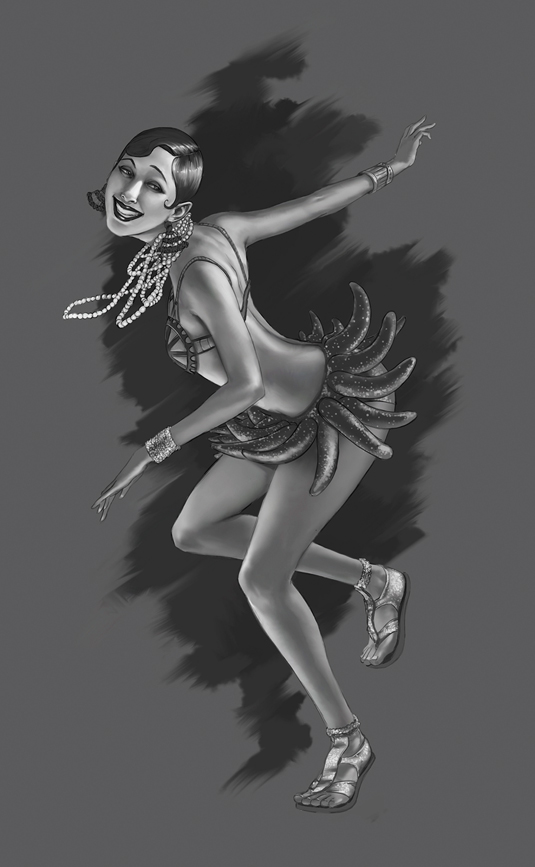How to create dynamic drawings from reference
Artist Tony Foti reveals how to add movement and interest to lifeless reference-based illustrations.

Don't actually copy your reference, use it as a guide. I know this can be daunting when you're just starting out, but the key to creating a dynamic pose from a model or photo is being comfortable pushing, stretching and moving bits around to make the drawing say what you want.
Hone your Illustrator skills with these brilliant tutorials
Part of this is just something that will come with time as you build up figure drawing mileage, but knowing what to strive for is half the battle. For this example, I want to really emphasise energy and motion, so I'm drawing the singer, dancer, actress, military spy and Legion of Honour recipient Josephine Baker.

The first sketch I've made – the left-hand one of the two drawings above – is a direct copy of the reference photo. Though I'm still making a lot of design choices in regards to line weight and what I leave out, shape-wise I've made no attempt to stray from the source image.
With this as a starting point, I'll show you how I push the pose to convey an idea. My goal is to use gesture, structure and technique to tell a bit of story with the drawing.
01. Decide on style

Decide how cartoony you want to get, what aspect of the model you want to communicate (personality trait, physical feature, particular motion and so on), then try to tell that story with the pose. In my case, there is an excitement to Josephine Baker's live performances (or videos of them, at least) that I don’t see in most posed photos. Conveying that will be my goal.
02. Stay loose

Technique and varying line weight can go a long way, but the foundation of a vibrant figure drawing is a descriptive gesture. Stay loose, experiment and have a clear centre line before adding in the limbs. Use fast, simple strokes to try out different ways of bending and stretching the body. Don't fuss with any single gesture, try out options until you find a pose that works for your theme.
Daily design news, reviews, how-tos and more, as picked by the editors.
03. Add fluidity

Partly because it's better for a tutorial and mostly because it's my favourite, I'm going with the pose that strays furthest from the source material. I've used a lot of fluid, curved lines to get that bubbly mood, so it's important to now sketch in anatomy and make sure everything is still working proportionally. When you bend and twist the body, it's vital to double-check your structure.
04. Focus on line work

As with the gesture and structure, you can push the character of the drawing by using thematically appropriate line work. An angry bouncer, say, might be drawn with short, straight, hard strokes. A drunk man stooped over a bar could be drawn with wavy, slightly disconnected lines. For this piece I'm focusing on smooth, jazzy curves that reinforce the happy mood I'm going for.
Artist's secret: shoot more reference

If a gesture drawing really captures the mood you're going for but strays too much from the original reference, just shoot or find some more. You don't need to redraw the gesture, just use the new reference to fill in any spots where you don't feel comfortable improvising.
Words: Tony Foti
Tony is a freelance illustrator who regularly contributes to Dungeons & Dragons and Fantasy Flight Games’ best-selling Star Wars and Lord of the Rings lines. This article originally appeared in ImagineFX magazine issue 121.
Like this? Read these!
- How to capture a story with your fantasy art
- Free Photoshop brushes every creative must have
- How to promote your art online

The Creative Bloq team is made up of a group of art and design enthusiasts, and has changed and evolved since Creative Bloq began back in 2012. The current website team consists of eight full-time members of staff: Editor Georgia Coggan, Deputy Editor Rosie Hilder, Ecommerce Editor Beren Neale, Senior News Editor Daniel Piper, Editor, Digital Art and 3D Ian Dean, Tech Reviews Editor Erlingur Einarsson, Ecommerce Writer Beth Nicholls and Staff Writer Natalie Fear, as well as a roster of freelancers from around the world. The ImagineFX magazine team also pitch in, ensuring that content from leading digital art publication ImagineFX is represented on Creative Bloq.
